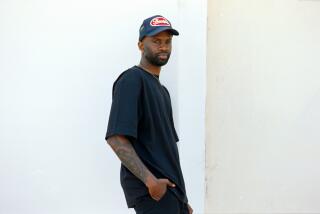Cadaver close-ups? It’s the news as usual
- Share via
Jay Leno called them “the most shocking pictures since Nick Nolte’s mug shot.”
Kidding aside, “shocking” overstates the impact of media-delivered head-and-chest shots of two men U.S. officials say are Saddam Hussein’s dead sons, Qusai and Uday.
Same goes for full-body views of these corpses first aired Friday, as media were invited in to photograph and videotape them right on the slab after their faces had been “reconstructed” to make them more lifelike in a stepped-up campaign to persuade Iraqis and other Middle Easterners that the brothers were dead.
The images were macabre and surreal, as if someone had provided a cinematic Hollywood ending to real life. They were also disturbing, as violent deaths always are.
But Americans are surely desensitized to this sort of thing by now, for the news is full of it. They’ve seen too much on television and in newspapers through the years to be jarred, revolted or horrified by pictures, however gruesome, that capture the consequences of violence along with the grim human behavior responsible for it.
Today’s older crowd, for example, saw Jack Ruby gun down Lee Harvey Oswald in 1963, saw Buddhist monks set themselves aflame to protest Saigon government polices in the 1960s, saw South Vietnamese Gen. Nguyen Ngoc Loan shoot a Viet Cong in the head at point-blank range in 1968.
These signature freeze frames resonate across generations, allowing us to commute to one age from another through a wormhole of technology. But with each instance, the shock of the death and violence diminishes.
In 1993, TV viewers watched an American soldier’s bound corpse dragged through the streets of Mogadishu by cheering crowds, scenes that influenced public opinion and, in effect, drove the U.S. from Somalia.
In the mid 1990s, a syndicated LAPD ride-along show fed Americans grisly close-ups of a man who hanged himself and the stiff body of another who overdosed on drugs.
They also saw Daniel V. Jones place a shotgun beneath his chin at a busy freeway intersection and blast half his head away in 1998, leaving his brains on the pavement.
With these and other turbulent incidents as background, a couple of shot-up, touched-up cadavers are unlikely to jolt many in the U.S., regardless of who these guys are.
Already they’ve become as much the furniture and wallpaper of newscasts as corpses are in HBO’s “Six Feet Under.”
“Before we get to the bodies of Uday and Qusai ... ,” CNN’s Wolf Blitzer began an interview Friday, as routinely as if speaking of Laci Peterson and JonBenet Ramsey.
Soon, in one of its instant polls whose results are ignored, CNN was asking viewers if TV was “overplaying” these pictures supplied by the military.
The decision by government and then media to put these images before the public will occupy TV’s and talk radio’s shouting and talking heads until something more provocative comes along for them to drive into the ground.
Pictures have always been a vehicle for broad metaphors that serve the foreign policies of governments. So it’s not surprising the Bush administration would want to display these bodies in hopes that convincing Iraqis that Hussein’s murderous sons were dead would ultimately lower violent resistance to the U.S. occupation. “The majority” of Iraqis believes the photos are genuine, CNN’s Nic Robertson reported Friday, without saying how he was able to poll the nation’s estimated population of 24.6 million.
Nor was it surprising that newscasts would decide to air them. And they’ll get no argument about it here, for even if the pictures don’t appear to closely resemble the Hussein brothers, they are significant at this stage of the Iraq story, if only to illustrate the U.S. government’s agenda.
If you have them, you run them (even though the same newscasters appear curiously reticent about zooming in with cameras on Americans killed in Iraq, as if the U.S. public couldn’t handle it).
Will making the pictures and morgue’s-eye-views available backfire on the U.S. by angering much of the Arab world it hopes to impress? MSNBC’s Jerry Nachman gave Friday’s smartest, most honest analysis when he replied: “Who knows?”
News value notwithstanding, there’s also a downside to beaming the Hussein bodies to America. Doing it surely lowers the bar of what’s acceptable to air on mainstream TV, an envelope that’s already being pushed in prime time by shows labeling themselves “reality.”
When one line is crossed, the next one is that much easier to traverse, then the next and the next. Be forewarned, grisly titillation and not news may be the purpose of the next set of cadaverous photos to come our way.
In any case, the truly shocking pictures may be the ones we don’t see on TV. They’re generated by the imagination, as in picturing what it must have been like in Santa Monica recently when an 86-year-old driver plowed through a crowded farmers market, killing 10 and injuring many more.
Although local stations delivered vivid live coverage of the aftermath, your brain generated even more powerful mental images. No close-ups of the dead required.
*
Howard Rosenberg’s column appears Mondays and Fridays. He can be contacted at howard.rosenberg@latimes.
com.
More to Read
Sign up for Essential California
The most important California stories and recommendations in your inbox every morning.
You may occasionally receive promotional content from the Los Angeles Times.













